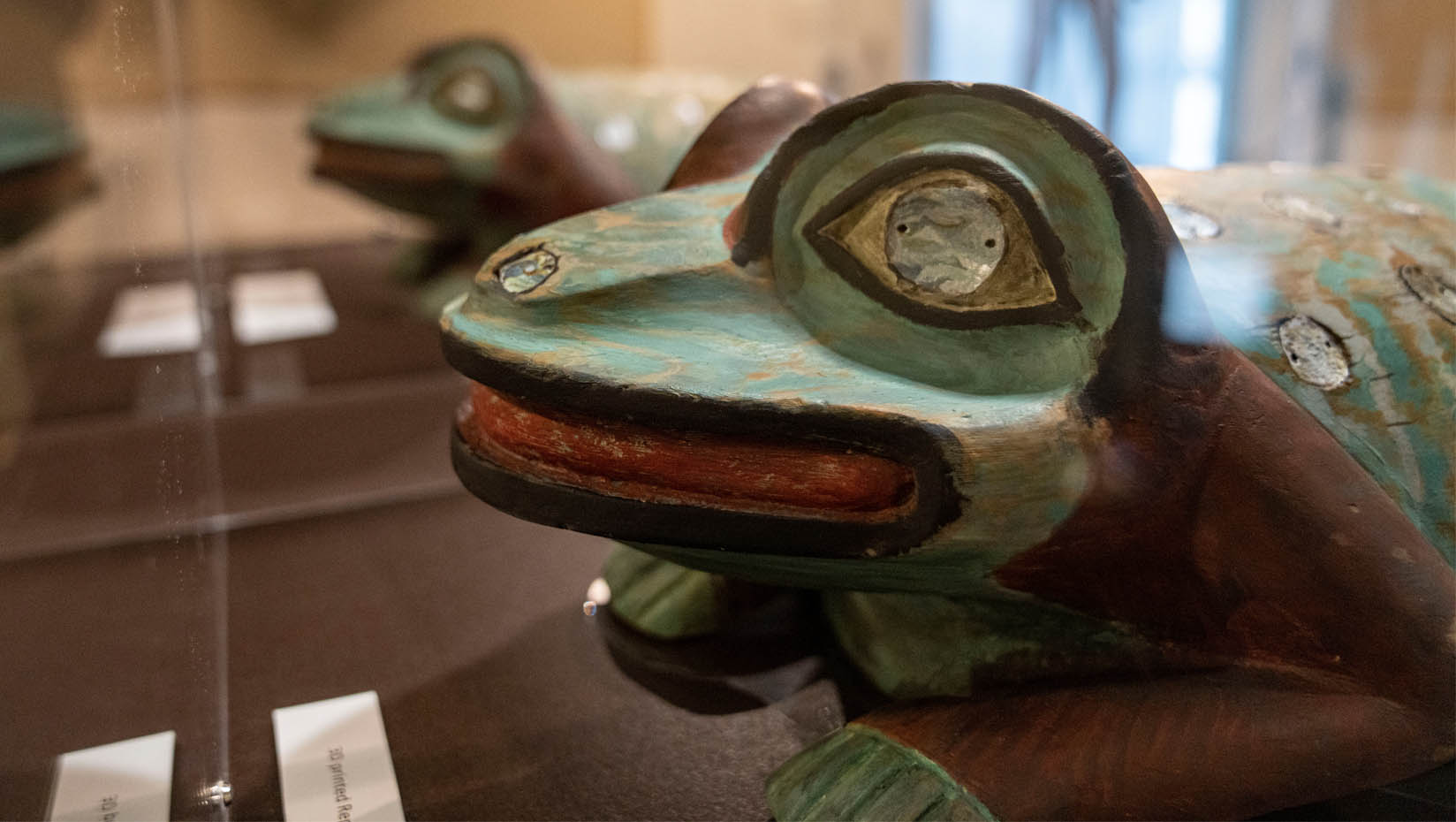
New exhibit featuring 3D-printed replica of 19th-century helmet opens at Hudson Museum
The University of Maine Hudson Museum has opened a new exhibit showcasing a 3D-printed replica of a 19th-century clan helmet from the Northwest Coast and photography that documents its creation.
The exhibit is located in the museum’s Minsky Culture Lab. The original Tlingit Frog Clan Helmet, carved out of yellow cedar, painted in green and red pigments and inlaid with abalone shell discs that were previously attached to a textile, sits alongside its identical replica. The 3D printed model was created by engineers from UMaine’s Advanced Structures and Composites Center and graduate students from the Intermedia Programs.
Both helmets are surrounded by photos depicting the stages in the process to create the replica and panels describing how the original helmet came to the museum, what sparked the efforts to recreate it, who worked on the project and their roles. The museum plans to incorporate time-lapse videos of engineers scanning the original and printing the replica and Intermedia Programs students’ roles in the project. The exhibit will be at the museum through early November, after which the museum will publish a digital version on its website.
The Frog Clan Helmet was part of a 1982 bequest to UMaine from the estate of William P. Palmer III, which included a gift of pre-Columbian objects that ranged from Olmec to Aztec, and an assemblage of Northwest Coast masks, potlatch bowls, Chilkat textiles and items made for sale outside the community.
In 2018, the Central Council of the Tlingit and Haida Indian Tribes of Alaska requested that the museum repatriate the helmet following a consultation visit to review its holdings as part of the Native American Graves Protection and Repatriation Act. The piece is part of an ongoing request from the council.
Museum director Gretchen Faulkner and her team sought to have a replica of the helmet made before beginning the formal process to repatriate the helmet. The replication project capitalizes on the Composites Center’s world-class expertise in 3D printing and the Intermedia Programs students’ skills in a museum setting. Harold Jacobs, cultural resources specialist for the council, granted permission for the recreation.
“This allows us to retain the replica to continue to educate visitors about Tlingit culture at the Hudson Museum and the importance of these objects to their communities,” Faulkner says.
The museum, Composites Center and Intermedia Programs received a $14,600 seed grant from the UMaine Arts Initiative for the project, “Technology and Tradition: Shaping Indigenous Collections for the Future.” It was one of five funded projects to receive seed grants as part of the initiative, which was launched in 2021 by the UMaine Office of the Vice President for Research and Dean of the Graduate School.
Composites Center research engineers Jonathan Roy and Alexander Cole led the scanning, digitizing and 3D printing of the prototype, created out of a durable thermoplastic that was sanded to a smooth finish. Intermedia graduate students Luke McKinney, Reed Hayden and Anna Martin also worked on the project. McKinney created the time lapses of the scanning and printing, while Hayden and Martin collaborated on the model finishing, painting and surface treatment to replicate the appearance of the original carving, including the helmet’s wood grain, Faulkner says. Duane Shimmel photographically documented all aspects of the project and is creating the exhibit video.
“This is an accurate reproduction of the piece,” Faulkner says, “but it’s not just about the ability to reproduce it. It’s also about the artists being able to bring it to life, reproducing the grain of the wood and wear patterns from traditional use.”
The project allowed the museum to develop a proof of concept for collection replication projects, help create protocols for these efforts with Indigenous communities and provide other collecting institutions with technical information about 3D scanning, printing and techniques for creating surfaces that resemble the original artifact or object.
“3D-printing doesn’t work for everything. It works for 3D solid objects, but not textiles or baskets,” Faulkner says. “This project allowed the museum to utilize cutting edge technology at UMaine, while collaborating with arts based units on campus. This project opens the door for future interdisciplinary collaborations.”
Contact: Marcus Wolf, 207.581.3721; marcus.wolf@maine.edu
